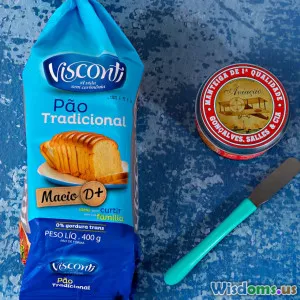
Why Serving Sizes on Snack Packages Can Be Misleading
9 min read Explore why snack serving sizes can mislead consumers and impact dietary choices. (0 Reviews)
Why Serving Sizes on Snack Packages Can Be Misleading
Food labels are a primary guide for consumers seeking healthier options or managing their dietary intake. Yet, a growing problem frustrates even the savviest shoppers: serving sizes printed on snack packages often don’t align with actual eating habits. This discrepancy can skew calorie counts and nutritional understanding, sometimes leading to unintended overeating and misinformed health decisions.
In this article, we will dissect why serving sizes can be deceptive, what regulatory frameworks influence them, and how consumers can better interpret these numbers to make informed choices.
The Complexity Behind Serving Sizes
What is a Serving Size?
By definition, a serving size is the standardized quantity of food recommended to be eaten at one time, intended to help compare nutrition information across products. Regulatory bodies, such as the U.S. Food and Drug Administration (FDA), define serving sizes based on average consumption data from national food surveys.
However, these standardized servings are often smaller than the portion a consumer would realistically eat, creating a gap between package information and actual intake.
Why Are Serving Sizes So Small?
Manufacturers sometimes design serving sizes strategically—smaller portions can make products appear healthier by showing lower calorie and nutrient counts per serving. For instance, a typical chip bag may list a serving as 15 chips, even if the entire bag contains 100 chips, subtly framing nutritional facts to look more favorable.
Nutritional scientist Dr. Marion Nestle explains, "Serving sizes on labels are often negotiation outcomes between public health goals and industry interests, leading to smaller, somewhat arbitrary serving portions that don’t reflect reality."
Regulatory Flexibility and Industry Influence
Food labeling regulations set ranges for serving size standards, but brands have flexibility within these parameters. The FDA last updated serving size guidelines in 2016—which caused many packaged foods’ serving sizes to increase closer to realistic consumption levels. Despite this, inconsistencies remain, especially in snack foods.
For example, the FDA’s reference unit for a standard chip serving may state 28 grams, but chips vary widely by brand, shape, and density, making one-size-fits-all serving measurements approximate at best.
Real-World Examples Illustrating Misleading Serving Sizes
The Case of Potato Chips
A common snack item like potato chips often highlights the issue vividly. Many bags list a serving as approximately 1 ounce (about 15-20 chips), but it’s not uncommon for people to consume a whole bag in one sitting.
Consider a standard 10-ounce bag with nutrition facts for one ounce. The label might say each serving has 150 calories and 10 grams of fat. If a person eats the entire bag, they’ve actually consumed 1,500 calories and 100 grams of fat—ten times the listed serving.
This gulf between indicated servings and real consumption undermines calorie awareness, increasing the risk of overeating.
Multi-Serving Packages Labeled as Single-Serving
Some snack packages blur lines by appearing to be single servings but contain multiple servings. For example, a 100-gram snack pack might be labeled with nutrition facts per 30 grams. While this complies with regulations, many consumers do not dissect packages or multiply nutritional content to estimate intake.
Research published in the Journal of Public Health Nutrition in 2020 found that consumers frequently underestimate calorie intake due to unclear serving size format, directly contributing to weight gain and poor diet quality.
The Impact on Consumer Behavior and Public Health
Implications for Weight Management
Inaccurate serving sizes encourage underestimating caloric intake, making weight control far more difficult. Overconsumption is often masked by optimistic labels, frustrating individuals tracking calories.
Dietitian Dawn Sobel notes, "When people rely solely on serving size packaging without considering the whole container or real eating habits, they're likely getting a false sense of security about their food consumption."
Nutritional Misinformation
Misleading servings can obscure crucial nutrient data, including saturated fats, sugars, and sodium, which are vital to monitor, especially for people with chronic conditions like diabetes or hypertension.
For example, a candy bar might list servings that imply low sugar content per piece, but eating multiple pieces quickly adds up to significant sugar overload.
How Consumers Can Navigate Serving Size Challenges
Reading Beyond the Serving Size
The first step is awareness. Consumers should evaluate the whole package nutritional content, not just per-serving data. Many packages provide this information near the serving size listing.
Using Measuring Tools and Visual Cues
Portion control tools, such as kitchen scales, measuring cups, or portion control plates, help adjust consumption closer to recommended servings, fostering accurate tracking.
Focus on Portion Size vs. Serving Size
Understanding the difference between serving size (a recommended amount) and portion size (what one actually eats) empowers smarter choices. Registered dietitians recommend visualizing portions using familiar objects (e.g., a deck of cards representing 3 ounces of meat) to stay realistic.
Advocate for Clearer Labeling
Consumer demand is pushing regulatory bodies and manufacturers toward clearer, more transparent labeling. Look for packaging with labeling that indicates package-wide calorie counts and realistic portion sizes.
Forward-Looking Perspectives
The Push for Standardization and Transparency
Groups such as the Center for Science in the Public Interest (CSPI) advocate for mandatory labeling of entire package contents alongside serving sizes to make health impacts clearer. The hope is these changes will empower consumers rather than confuse them.
Technology as an Aid
Smartphone apps today can scan barcodes and calculate total nutritional content for full packages, easing tracking burdens and compensating for tricky serving sizes.
Conclusion
Serving sizes on snack packages often present a distorted view of what people actually consume. Smaller, arbitrary serving counts can mislead consumers about calories, fats, sugars, and other nutrients, impacting weight management and overall health.
By understanding regulatory nuances, reading labels critically, and leveraging tools to estimate real portions, individuals can reclaim control over their dietary health. Better labeling standards and consumer advocacy will further enhance transparency, making nutritive information more trustworthy.
Empowered with knowledge, readers can approach snack packaging skeptically—looking beyond the serving size to the bigger nutritional picture and making well-informed food choices.
References
- Nestle, Marion. Food Politics. University of California Press, 2013.
- U.S. Food and Drug Administration. (2016). Food Labeling: Serving Sizes Updates.
- Journal of Public Health Nutrition, 2020, "Consumer perceptions of serving size labeling on snack foods."
- Center for Science in the Public Interest (CSPI) reports on food labeling.
- Interview with Dawn Sobel, MS, RD, Nutrition Expert.
Rate the Post
User Reviews
Other posts in Food Labeling & Nutrition Facts
Popular Posts
















